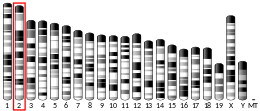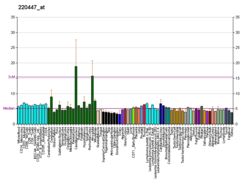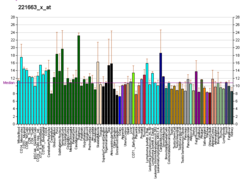히스타민H수용체3
Histamine H3 receptor| HRH3 | |||||||||||||||||||||||||||||||||||||||||||||||||||
|---|---|---|---|---|---|---|---|---|---|---|---|---|---|---|---|---|---|---|---|---|---|---|---|---|---|---|---|---|---|---|---|---|---|---|---|---|---|---|---|---|---|---|---|---|---|---|---|---|---|---|---|
| 식별자 | |||||||||||||||||||||||||||||||||||||||||||||||||||
| 에일리어스 | HRH3, GPCR97, HH3R, 히스타민수용체 H3 | ||||||||||||||||||||||||||||||||||||||||||||||||||
| 외부 ID | OMIM : 604525 MGI : 2139279 HomoloGene : 5232 GenCard : HRH3 | ||||||||||||||||||||||||||||||||||||||||||||||||||
| |||||||||||||||||||||||||||||||||||||||||||||||||||
| |||||||||||||||||||||||||||||||||||||||||||||||||||
| |||||||||||||||||||||||||||||||||||||||||||||||||||
| |||||||||||||||||||||||||||||||||||||||||||||||||||
| |||||||||||||||||||||||||||||||||||||||||||||||||||
| 위키데이터 | |||||||||||||||||||||||||||||||||||||||||||||||||||
| |||||||||||||||||||||||||||||||||||||||||||||||||||
히스타민H3 수용체는 중추신경계와 말초신경계에서 발현되며, 말초신경계는 시냅스 전 히스타민 작동성 뉴런에서 자가수용체로 작용하며, 히스타민 합성과 [5]방출의 피드백 저지에 의해 히스타민 회전을 제어한다.또한 H 수용체는3 도파민, GABA, 아세틸콜린, 노르아드레날린, 히스타민 및 세로토닌을 포함하지만 이에 국한되지는 않는 많은 다른 신경전달물질(즉 억제성 이질수용체 역할을 함)의 방출을 사전 적응적으로 억제하는 것으로 나타났다.
H 수용체에 대한3 유전자 배열은 각각 H 수용체와2 H 수용체 모두에1 대해 약 22%, 20%만 호몰로지를 발현한다.
히스타민 H3 수용체는 많은 인지 장애의 배후에 있는 신경 메커니즘과 특히 중추 신경계에서 [6][7]그것의 위치에 관여하기 때문에 잠재적인 치료 대상으로 많은 관심이 있다.
조직 분포
기능.
모든 히스타민 수용체와 마찬가지로 H 수용체는3 G-단백질 결합 수용체이다.H 수용체는3 G-단백질에i 결합되어 있기 때문에 cAMP의 형성을 억제하고, 또한 β 및 β 서브유닛은 N형 전압 게이트 칼슘 채널과 상호작용하여 칼슘의 작용 매개 유입을 감소시켜 신경전달물질 방출을 감소시킨다.H3 수용체는 히스타민이 함유된 [8]뉴런에서 시냅스 전 자가수용체로 기능한다.
피질과 피질 전체에 걸친 H 수용체의 다양한3 발현은 많은 수의 신경 전달 물질의 방출을 조절하는 능력을 나타냅니다.
H3 수용체들은 [9]포만감을 조절하는 역할을 하는 것으로 생각된다.
Isoforms
인간에는 적어도 6개의3 H 수용체 동소형이 있으며,[10] 지금까지 발견된 것은 20개 이상.쥐의 경우 지금까지 확인된 6가지 Hreceptor3 아형이 있다.쥐는 또한 보고된 세 개의 등소 [11]형태를 가지고 있다.이들 아형은 모두 약리학적 차이가 미묘하지만(그리고 아마도 랫드의 연구에 기초한 분포) 이들 아이소폼의 정확한 생리학적 역할은 여전히 불분명하다.
약리학
어거니스트
H 수용체에 대한 선택적3 작용제 역할을 하는 치료 제품은 현재 존재하지 않지만, 연구 도구로 사용되는 여러 가지 화합물은 상당히 선택적 작용제이다.예를 들어 다음과 같습니다.
- (R)-α-메틸히스타민
- Cipralisant(처음에는 H 길항제로서 평가되고3 나중에 작용제로 판명되어 기능적 선택성을 나타내며, 일부 G단백질 결합 경로를 활성화하지만 [12]다른 경로는 활성화하지 않음)
- 임부타민(H4 어거니스트도 있음)
- Immepip
- Imetit
- Immethridine
- Methimepip
- 프록시팬(복잡한 기능선택성, cAMP 억제 및 MAPK 활성에 대한 부분작용제 효과, 히스타민 방출에 대한 길항제, 아라키돈산 방출에 대한 역작용제)
대항마
여기에는 다음이 포함됩니다.[13]
- A-304121(공차 형성 없음, 무음 길항제)[14]
- A-349,821[15]
- ABT-239
- 베타히스티나(또한 약한1 H작용제)
- 부리마미드(또한2 약한 H 길항제
- 시프록시판
- Clobenpropit(H 길항제도 있음4)
- 코네신
- 페일록시판[citation needed](공차 [citation needed]형성 없음)
- 임펜타민
- 요오드펜프로핏
- 이르다비산트
- 피톨리산트
- 티오페라미드(H4 안타고니스트도 포함)
- VUF-5681 (4-[3-(1H-이미다졸-4-일)프로필]피페리딘)
치료 가능성
H3 수용체는 중추신경계 및 다른 신경전달물질의 [6][16][17]조절과 연결되기 때문에 히스타민 작동성 H3R 기능 장애로 인해 발생하는 많은 (인지) 장애에 대한 유망한 치료 대상입니다.그러한 장애의 예로는 수면 장애(기면증 포함), 투렛 증후군, 파킨슨, 강박장애, ADHD, ASS, 약물 [6][17]중독 등이 있다.
이 수용체는 수면 [18]장애 치료 대상으로 제안되었다.이 수용체는 또한 신경성 [19]통증을 치료하기 위한 표적으로 제안되었다.
그것의 능력 다른 신경 전달 물질을 조정하기 위해 때문에,H3 수용체 ligands 비만(그histamine/orexinergic 시스템 상호 작용 때문에), 움직임 disorders(도파민과 GABA의 기저 신경절에 H3receptor-modulation 때문에), 분열증과 포함한 수많은 신경 질환의 치료를 위해 조사를 받고 있다.aDHD(도파민 변조 때문에)와 H 수용체 리간드가 각성 조절에 유용할 수 있는지 여부를3 결정하기 위한 연구가 진행 중이다(노아드레날린, 글루타메이트 및 [20][7]히스타민에 대한 영향).
H3 수용체가 투레트 [21]증후군에 중요한 역할을 한다는 증거도 있다.마우스 모델 및 다른 연구에서는 H3R에서 히스타민 농도가 감소하면 틱스가 발생하지만 선조체에 히스타민을 첨가하면 증상이 [22][23][24]감소하는 것으로 나타났습니다.히스타민(H3 수용체)과 도파민 및 다른 신경전달물질 사이의 상호작용은 이 장애의 [25]이면에 있는 중요한 기본 메커니즘이다.
역사
- 19833 H 수용체는 약리학적으로 [26]식별된다.
- 1988 H3 수용체는 쥐 뇌피질에서 [27]세로토닌 방출 억제를 매개하는 것으로 밝혀졌다.
- 1997 H3 수용체들은 [28]동물의 허혈성 노르에피네프린 방출을 조절하는 것으로 나타났다.
- 19993 H 수용체 복제[29]
- 심근허혈의 [30]신개척지라고 하는 2000H3 수용체
- 20023(-/-) H 마우스(이 [31]수용체가 없는 쥐)
「 」를 참조해 주세요.
레퍼런스
- ^ a b c GRCh38: 앙상블 릴리즈 89: ENSG00000101180 - 앙상블, 2017년 5월
- ^ a b c GRCm38: 앙상블 릴리즈 89: ENSMUSG000039059 - 앙상블, 2017년 5월
- ^ "Human PubMed Reference:". National Center for Biotechnology Information, U.S. National Library of Medicine.
- ^ "Mouse PubMed Reference:". National Center for Biotechnology Information, U.S. National Library of Medicine.
- ^ West RE, Zweig A, Shih NY, Siegel MI, Egan RW, Clark MA (Nov 1990). "Identification of two H3-histamine receptor subtypes" (abstract). Molecular Pharmacology. 38 (5): 610–3. PMID 2172771.
- ^ a b c 라파넬리, 막시밀리아노"멋진 두 사람:히스타민과 H3 수용체가 선조체 회로의 핵심 조절체입니다."신경심리약리학 및 생물학적 정신의학 발전 73(2017년 2월) : 36~40년
- ^ a b 사덱, 바셈, 알리 사드, 아델 사덱, 파흐레야 잘랄, 홀거 스타크."신경정신 질환의 인지 증상의 잠재적 표적으로 히스타민 H3 수용체"행동뇌연구 312회(2016년 10월): 415~430회
- ^ "InterPro: IPR003980 Histamine H3 receptor". InterPro. European Bioinformatics Institute.
- ^ Attoub S, Moizo L, Sobhani I, Laigneau JP, Lewin MJ, Bado A (Jun 2001). "The H3 receptor is involved in cholecystokinin inhibition of food intake in rats". Life Sciences. 69 (4): 469–78. doi:10.1016/S0024-3205(01)01138-9. PMID 11459437.
- ^ Bakker RA (Oct 2004). "Histamine H3-receptor isoforms". Inflammation Research. 53 (10): 509–16. doi:10.1007/s00011-004-1286-9. PMID 15597144. S2CID 9630188.
- ^ Rouleau A, Héron A, Cochois V, Pillot C, Schwartz JC, Arrang JM (Sep 2004). "Cloning and expression of the mouse histamine H3 receptor: evidence for multiple isoforms". Journal of Neurochemistry. 90 (6): 1331–8. doi:10.1111/j.1471-4159.2004.02606.x. PMID 15341517. S2CID 29078902.
- ^ Krueger KM, Witte DG, Ireland-Denny L, et al. (July 2005). "G protein-dependent pharmacology of histamine H3 receptor ligands: evidence for heterogeneous active state receptor conformations". J. Pharmacol. Exp. Ther. 314 (1): 271–81. doi:10.1124/jpet.104.078865. PMID 15821027. S2CID 20470970.
- ^ Tedford CE, Phillips JG, Gregory R, Pawlowski GP, Fadnis L, Khan MA, Ali SM, Handley MK, Yates SL (May 1999). "Development of trans-2-[1H-imidazol-4-yl] cyclopropane derivatives as new high-affinity histamine H3 receptor ligands" (abstract). The Journal of Pharmacology and Experimental Therapeutics. 289 (2): 1160–8. PMID 10215700.
- ^ Pan, Jia Bao; Yao, Betty B.; Miller, Thomas R.; Kroeger, Paul E.; Bennani, Youssef L.; Komater, Victoria A.; Esbenshade, Timothy A.; Hancock, Arthur A.; Decker, Michael W.; Fox, Gerard B. (2006-08-29). "Evidence for tolerance following repeated dosing in rats with ciproxifan, but not with A-304121". Life Sciences. 79 (14): 1366–1379. doi:10.1016/j.lfs.2006.04.002. ISSN 0024-3205. PMID 16730751.
- ^ Esbenshade TA, Fox GB, Krueger KM, et al. (September 2004). "Pharmacological and behavioral properties of A-349821, a selective and potent human histamine H3 receptor antagonist". Biochem. Pharmacol. 68 (5): 933–45. doi:10.1016/j.bcp.2004.05.048. PMID 15294456.
- ^ 볼람, J. 폴, 토마스 J. 엘렌더."히스타민과 선조체"신경약리학 106 (2016년 7월) : 74 ~ 84
- ^ a b 사덱, 바셈, 알리 사드, 아델 사덱, 파흐레야 잘랄, 홀거 스타크."신경정신 질환의 인지 증상의 잠재적 표적으로 히스타민 H3 수용체"행동뇌연구 312회(2016년 10월): 415~430회
- ^ Passani MB, Lin JS, Hancock A, Crochet S, Blandina P (Dec 2004). "The histamine H3 receptor as a novel therapeutic target for cognitive and sleep disorders". Trends in Pharmacological Sciences. 25 (12): 618–25. doi:10.1016/j.tips.2004.10.003. PMID 15530639.
- ^ Medhurst SJ, Collins SD, Billinton A, Bingham S, Dalziel RG, Brass A, Roberts JC, Medhurst AD, Chessell IP (Aug 2008). "Novel histamine H3 receptor antagonists GSK189254 and GSK334429 are efficacious in surgically-induced and virally-induced rat models of neuropathic pain". Pain. 138 (1): 61–9. doi:10.1016/j.pain.2007.11.006. PMID 18164820. S2CID 43724064.
- ^ Leurs R, Bakker RA, Timmerman H, de Esch IJ (Feb 2005). "The histamine H3 receptor: from gene cloning to H3 receptor drugs". Nature Reviews. Drug Discovery. 4 (2): 107–20. doi:10.1038/nrd1631. PMID 15665857. S2CID 32781560.
- ^ 콕스, 조안나 H, 스테파노 세리, 안드레아 E. 카반나."투레트 증후군의 역사민 조절"고아약품 전문가 의견 4, 2호(2016년 2월 1일) : 205~213
- ^ 볼람, J. 폴, 토마스 J. 엘렌더."히스타민과 선조체"신경약리학 106 (2016년 7월) : 74 ~ 84
- ^ 라파넬리, 막시밀리아노, 루시아나 프릭, 하루히코 비토, 크리스토퍼 피텐거."병리학적 그루밍 발달에 있어 기저신경절 회로의 히스타민 조절"미국국립과학원 회의(2017년 6월 5일) : 6599~6604
- ^ 라파넬리, 막시밀리아노, 크리스토퍼 피텐거."투레트 증후군과 다른 신경정신 질환의 히스타민 수용체와 히스타민 수용체"신경약리학 106 (2016년 7월) : 85 ~ 90
- ^ 발단, 리산드라 카스텔란, 카일 A윌리엄스, 장 도미니크 갈레조, 블라디미르 포고렐로프, 막시밀리아노 라파넬리, 마이클 크롤리, 조지 M.앤더슨 등"히스티딘 탈카르복실화효소 결핍은 투레트 증후군을 일으킨다: 인간과 생쥐의 병렬 발견"뉴런 81, No.1 (2014년 1월 8일) : 77~90
- ^ Arrang JM, Garbarg M, Schwartz JC (Apr 1983). "Auto-inhibition of brain histamine release mediated by a novel class (H3) of histamine receptor". Nature. 302 (5911): 832–7. Bibcode:1983Natur.302..832A. doi:10.1038/302832a0. PMID 6188956. S2CID 4302564.
- ^ Schlicker E, Betz R, Göthert M (May 1988). "Histamine H3 receptor-mediated inhibition of serotonin release in the rat brain cortex". Naunyn-Schmiedeberg's Archives of Pharmacology. 337 (5): 588–90. doi:10.1007/BF00182737. PMID 3412497. S2CID 24168192.
- ^ Hatta E, Yasuda K, Levi R (Nov 1997). "Activation of histamine H3 receptors inhibits carrier-mediated norepinephrine release in a human model of protracted myocardial ischemia" (abstract). The Journal of Pharmacology and Experimental Therapeutics. 283 (2): 494–500. PMID 9353362.
- ^ Lovenberg TW, Roland BL, Wilson SJ, Jiang X, Pyati J, Huvar A, Jackson MR, Erlander MG (Jun 1999). "Cloning and functional expression of the human histamine H3 receptor". Molecular Pharmacology. 55 (6): 1101–7. doi:10.1124/mol.55.6.1101. PMID 10347254.
- ^ Levi R, Smith NC (Mar 2000). "Histamine H(3)-receptors: a new frontier in myocardial ischemia" (abstract). The Journal of Pharmacology and Experimental Therapeutics. 292 (3): 825–30. PMID 10688593.
- ^ Toyota H, Dugovic C, Koehl M, Laposky AD, Weber C, Ngo K, Wu Y, Lee DH, Yanai K, Sakurai E, Watanabe T, Liu C, Chen J, Barbier AJ, Turek FW, Fung-Leung WP, Lovenberg TW (Aug 2002). "Behavioral characterization of mice lacking histamine H(3) receptors". Molecular Pharmacology. 62 (2): 389–97. doi:10.1124/mol.62.2.389. PMID 12130692.
추가 정보
- Hill SJ, Ganellin CR, Timmerman H, Schwartz JC, Shankley NP, Young JM, Schunack W, Levi R, Haas HL (Sep 1997). "International Union of Pharmacology. XIII. Classification of histamine receptors". Pharmacological Reviews. 49 (3): 253–78. PMID 9311023.
- Malinowska B, Godlewski G, Schlicker E (Jun 1998). "Histamine H3 receptors--general characterization and their function in the cardiovascular system". Journal of Physiology and Pharmacology. 49 (2): 191–211. PMID 9670104.
- Leurs R, Hoffmann M, Wieland K, Timmerman H (Jan 2000). "H3 receptor gene is cloned at last". Trends in Pharmacological Sciences. 21 (1): 11–2. doi:10.1016/S0165-6147(99)01411-X. PMID 10637648.
- Leurs R, Bakker RA, Timmerman H, de Esch IJ (Feb 2005). "The histamine H3 receptor: from gene cloning to H3 receptor drugs". Nature Reviews. Drug Discovery. 4 (2): 107–20. doi:10.1038/nrd1631. PMID 15665857. S2CID 32781560.
- Esbenshade TA, Fox GB, Cowart MD (Apr 2006). "Histamine H3 receptor antagonists: preclinical promise for treating obesity and cognitive disorders". Molecular Interventions. 6 (2): 77–88, 59. doi:10.1124/mi.6.2.5. PMID 16565470.
- Lovenberg TW, Roland BL, Wilson SJ, Jiang X, Pyati J, Huvar A, Jackson MR, Erlander MG (Jun 1999). "Cloning and functional expression of the human histamine H3 receptor". Molecular Pharmacology. 55 (6): 1101–7. doi:10.1124/mol.55.6.1101. PMID 10347254.
- Nakamura T, Itadani H, Hidaka Y, Ohta M, Tanaka K (Dec 2000). "Molecular cloning and characterization of a new human histamine receptor, HH4R". Biochemical and Biophysical Research Communications. 279 (2): 615–20. doi:10.1006/bbrc.2000.4008. PMID 11118334.
- Cogé F, Guénin SP, Audinot V, Renouard-Try A, Beauverger P, Macia C, Ouvry C, Nagel N, Rique H, Boutin JA, Galizzi JP (Apr 2001). "Genomic organization and characterization of splice variants of the human histamine H3 receptor". The Biochemical Journal. 355 (Pt 2): 279–88. doi:10.1042/0264-6021:3550279. PMC 1221737. PMID 11284713.
- Silver RB, Poonwasi KS, Seyedi N, Wilson SJ, Lovenberg TW, Levi R (Jan 2002). "Decreased intracellular calcium mediates the histamine H3-receptor-induced attenuation of norepinephrine exocytosis from cardiac sympathetic nerve endings". Proceedings of the National Academy of Sciences of the United States of America. 99 (1): 501–6. Bibcode:2002PNAS...99..501S. doi:10.1073/pnas.012506099. PMC 117589. PMID 11752397.
- Wiedemann P, Bönisch H, Oerters F, Brüss M (Apr 2002). "Structure of the human histamine H3 receptor gene (HRH3) and identification of naturally occurring variations". Journal of Neural Transmission. 109 (4): 443–53. doi:10.1007/s007020200036. PMID 11956964. S2CID 32434148.
- Wellendorph P, Goodman MW, Burstein ES, Nash NR, Brann MR, Weiner DM (Jun 2002). "Molecular cloning and pharmacology of functionally distinct isoforms of the human histamine H(3) receptor". Neuropharmacology. 42 (7): 929–40. doi:10.1016/S0028-3908(02)00041-2. PMID 12069903. S2CID 54326678.
- Lozeva V, Tuomisto L, Tarhanen J, Butterworth RF (Oct 2003). "Increased concentrations of histamine and its metabolite, tele-methylhistamine and down-regulation of histamine H3 receptor sites in autopsied brain tissue from cirrhotic patients who died in hepatic coma". Journal of Hepatology. 39 (4): 522–7. doi:10.1016/S0168-8278(03)00353-2. PMID 12971961.
- Lippert U, Artuc M, Grützkau A, Babina M, Guhl S, Haase I, Blaschke V, Zachmann K, Knosalla M, Middel P, Krüger-Krasagakis S, Henz BM (Jul 2004). "Human skin mast cells express H2 and H4, but not H3 receptors". The Journal of Investigative Dermatology. 123 (1): 116–23. doi:10.1111/j.0022-202X.2004.22721.x. PMID 15191551.
외부 링크
- "Histamine Receptors: H3". IUPHAR Database of Receptors and Ion Channels. International Union of Basic and Clinical Pharmacology.
- 미국 국립 의학 도서관(MeSH)의 H3+ 수용체









